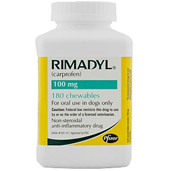An aural hematoma is a blood-filled
pocket that forms between the layers of tissue in a dog's ear flap
or pinna. Aural hematomas have a characteristic look and feel.
They are soft, swollen areas that are often warm to the touch.
A hematoma makes a dog's ear flap much thicker and "squishier"
than it would be otherwise. Hematomas may be painful.
What Causes Aural Hematomas?
The blood in a hematoma originates
from broken blood vessels. Blood vessels in the ears can be broken
when a dog shakes its head vigorously, scratches excessively, or has
any sort of trauma to the area. The most common causes of head
shaking and ear scratching in dogs are ear infections, ear mite infestations, foreign materials (e.g., grass awns) that become lodged within the ear
canal, and allergies.
"An equally important part of treatment is determining why a dog has been shaking its head or scratching its ears."
Treatment
Surgery is the best way to treat an
aural hematoma. Simply lancing it and draining away the accumulated
blood is almost never successful in the long run. Without treatment,
the hematoma may eventually be resorbed by the body, but the pinna is
often disfigured in the process.
Most veterinarians make an S-shaped
incision over the swelling, remove the blood that has accumulated, and
then place multiple sutures through the ear to hold the tissues together.
This prevents blood from becoming trapped in the area again. The
incision is left open so that any new bleeding that occurs has a way
to exit the ear. Some veterinarians make an incision and place
a small tube into the pocket to promote drainage.
Bandaging may also be necessary to
put pressure on the affected tissues and/or protect the area.
Most dogs need to wear an Elizabethan collar to stop them from scratching
or rubbing the incision, sutures, drain, or bandages. Sutures
are usually removed approximately 14 days after surgery as long as everything appears to be healing well.

An equally important part of treatment
is determining why a dog has been shaking its head or scratching its
ears. While the dog is under anesthesia for surgical repair of
the hematoma, the veterinarian will thoroughly examine its ears and
clean them out if necessary. Any foreign material will need to
be removed, and samples of debris from the ear will be examined under
the microscope. Treatment for yeast infections, bacterial infections
or ear mite infestations will be recommended as needed. Pain medications like Rimadyl and antibiotics may also be prescribed to ensure healthy healing and patient comfort after surgery.
Prevention
Many aural hematomas could be prevented
if owners closely monitored the health of their pets' ears.
Examine them weekly. If debris is starting to build-up, wash out
your dog's ears with a canine ear cleaner. If you
notice your dog starting to scratch his ears or shake his head excessively,
take him to a veterinarian before the situation gets bad enough for
an aural hematoma to form.
The above is provided for information purposes only and should not be used for the diagnosis or treatment of any condition.
This information does not cover all possible variables, conditions, reactions, or risks relating to any topic, medication, or product and should not
be considered complete. Certain products or medications may have risks and you should always consult your local veterinarian concerning the treatment of
your pet. Any trademarks are the property of their respective owners.